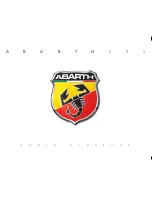
||
WHEELS AND TIRES
440
WARNING
•
Exceeding the permissible axle weight,
gross vehicle weight, or any other weight
rating limits can cause tire overheating
resulting in permanent deformation or
catastrophic failure.
•
Do not use replacement tires with lower
load carrying capacities than the tires that
were original equipment on the vehicle
because this will lower the vehicle's GVW
rating. Use only tires with the correct load
carrying capacity. Consult your Volvo
retailer for information.
Related information
•
Label information (p. 508)
•
Weights (p. 513)
Uniform Tire Quality Grading
ALL PASSENGER VEHICLE TIRES MUST
CONFORM TO FEDERAL SAFETY REQUIRE-
MENTS IN ADDITION TO THESE GRADES
.
Quality grades can be found, where applica-
ble, on the tire sidewall between the tread
shoulder and maximum section width. For
example:
Treadwear 200 Traction AA Temperature A
TREADWEAR
The treadwear grade is a comparative rating
based on the wear rate of the tire when tested
under controlled conditions on a specified gov-
ernment test course. For example, a tire graded
150 would wear one and one half (1 ½) times as
well on the government course as a tire graded
100. The relative performance of tires depends
upon the actual conditions of their use, however,
and many depart significantly from the norm due
to variation in driving habits, maintenance practi-
ces and differences in road characteristics and
climate.
TRACTION
The traction grades, from highest to lowest, are
AA, A, B, and C, as measured under controlled
conditions on specified government test surfaces
of asphalt and concrete. A tire marked C may
have poor traction performance. The traction
grade assigned to this tire is based on braking
(straight-ahead) traction tests and is not a meas-
ure of cornering (turning) traction.
WARNING
The traction grade assigned to this tire is
based on braking (straight-ahead) traction
tests and is not a measure of cornering (turn-
ing) traction.
TEMPERATURE
The temperature grades are A (the highest), B,
and C, representing the tire's resistance to the
generation of heat and its ability to dissipate heat
when tested under controlled conditions on a
specified indoor laboratory test wheel. Sustained
high temperature can cause the material of the
tire to degenerate and reduce tire life, and exces-
sive temperature can lead to sudden tire failure.
The grade C corresponds to a minimum level of
performance that all passenger vehicle tires must
meet under the Federal Motor Safety Standard
No. 109. Grades B and A represent higher levels
of performance on the laboratory test wheel than
the minimum required by law.
WARNING
The temperature grade for this tire is estab-
lished for a tire that is properly inflated and
not overloaded. Excessive speed, under-infla-
tion, or excessive loading, either separately or
in combination, can cause heat buildup and
tire failure.
Summary of Contents for XC90 T8 TwinEngine Plug-In Hybrid
Page 1: ...WEB EDITION OWNER S MANUAL...
Page 2: ......
Page 13: ...INTRODUCTION...
Page 17: ...INTRODUCTION 15 Overview...
Page 19: ...INTRODUCTION 17 Preparations for charging the hybrid battery p 372 Starting the engine p 364...
Page 58: ......
Page 59: ...SAFETY...
Page 94: ...SAFETY 92 Related information Airbag system p 87 Seat belts p 62...
Page 95: ...INSTRUMENTS AND CONTROLS...
Page 175: ...CLIMATE...
Page 204: ......
Page 205: ...LOADING AND STORAGE...
Page 221: ...LOCKS AND ALARM...
Page 246: ......
Page 247: ...DRIVER SUPPORT...
Page 339: ...STARTING AND DRIVING...
Page 396: ......
Page 397: ...INFOTAINMENT...
Page 434: ......
Page 435: ...WHEELS AND TIRES...
Page 462: ......
Page 463: ...MAINTENANCE AND SERVICING...
Page 508: ......
Page 509: ...SPECIFICATIONS...
Page 511: ...SPECIFICATIONS 509 Location of labels...
Page 533: ......
















































